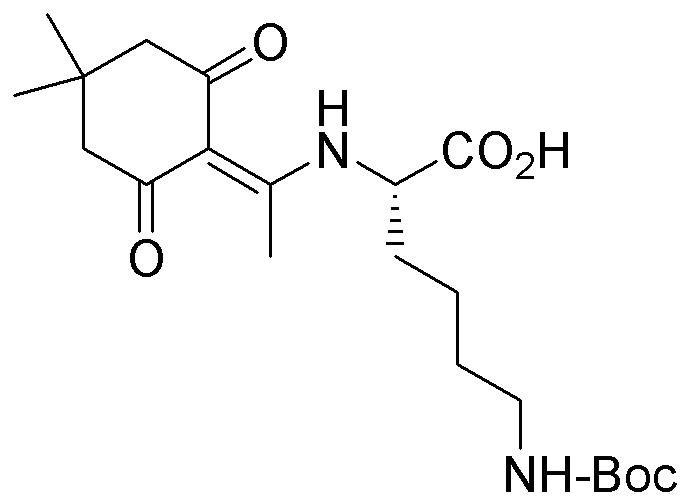Na-1-(4,4-Dimethyl-2,6-dioxocyclohex-1-ylidene)ethyl-Ne-Boc-L-lysine is widely utilized in research focused on:
- Peptide Synthesis: This compound serves as a valuable building block in the synthesis of peptides, particularly in the development of biologically active compounds.
- Drug Development: Its unique structure allows for modifications that can enhance the pharmacological properties of new drug candidates, making it essential in pharmaceutical research.
- Bioconjugation: It is used in bioconjugation processes to attach biomolecules to surfaces or other molecules, aiding in the development of targeted therapies.
- Research on Enzyme Inhibition: The compound is explored for its potential to inhibit specific enzymes, which is crucial in understanding disease mechanisms and developing treatments.
- Material Science: It finds applications in the creation of novel materials with specific properties, contributing to advancements in fields like nanotechnology and biomaterials.
General Information
Properties
Safety and Regulations
Applications
Na-1-(4,4-Dimethyl-2,6-dioxocyclohex-1-ylidene)ethyl-Ne-Boc-L-lysine is widely utilized in research focused on:
- Peptide Synthesis: This compound serves as a valuable building block in the synthesis of peptides, particularly in the development of biologically active compounds.
- Drug Development: Its unique structure allows for modifications that can enhance the pharmacological properties of new drug candidates, making it essential in pharmaceutical research.
- Bioconjugation: It is used in bioconjugation processes to attach biomolecules to surfaces or other molecules, aiding in the development of targeted therapies.
- Research on Enzyme Inhibition: The compound is explored for its potential to inhibit specific enzymes, which is crucial in understanding disease mechanisms and developing treatments.
- Material Science: It finds applications in the creation of novel materials with specific properties, contributing to advancements in fields like nanotechnology and biomaterials.
Documents
Safety Data Sheets (SDS)
The SDS provides comprehensive safety information on handling, storage, and disposal of the product.
Product Specification (PS)
The PS provides a comprehensive breakdown of the product’s properties, including chemical composition, physical state, purity, and storage requirements. It also details acceptable quality ranges and the product's intended applications.
Certificates of Analysis (COA)
Search for Certificates of Analysis (COA) by entering the products Lot Number. Lot and Batch Numbers can be found on a product’s label following the words ‘Lot’ or ‘Batch’.
*Catalog Number
*Lot Number
Certificates Of Origin (COO)
This COO confirms the country where the product was manufactured, and also details the materials and components used in it and whether it is derived from natural, synthetic, or other specific sources. This certificate may be required for customs, trade, and regulatory compliance.
*Catalog Number
*Lot Number
Safety Data Sheets (SDS)
The SDS provides comprehensive safety information on handling, storage, and disposal of the product.
DownloadProduct Specification (PS)
The PS provides a comprehensive breakdown of the product’s properties, including chemical composition, physical state, purity, and storage requirements. It also details acceptable quality ranges and the product's intended applications.
DownloadCertificates of Analysis (COA)
Search for Certificates of Analysis (COA) by entering the products Lot Number. Lot and Batch Numbers can be found on a product’s label following the words ‘Lot’ or ‘Batch’.
*Catalog Number
*Lot Number
Certificates Of Origin (COO)
This COO confirms the country where the product was manufactured, and also details the materials and components used in it and whether it is derived from natural, synthetic, or other specific sources. This certificate may be required for customs, trade, and regulatory compliance.


